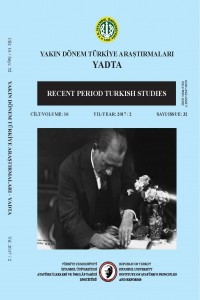Abstract
Yüzyıllar boyu Müslümanlar için tasavvufi hayatın merkezi konumunda bulunan tekkeler 1925 yılı itibariyle 677 sayılı kanun kapsamında kapatılmışlardır. Bu değişimi ve çağdaşlaşmayı amaçlayan yeni bir rejimin gerçekleştirdiği bir dizi inkılabın yalnızca bir halkasını teşkil etmektedir. Tekkelerin ve tarikatların; oluşturulması hedeflenen yeni toplum yapısına zıt bir görüntü arz etmesi; Şeyh Said İsyanı örneğinde olduğu gibi dönemin siyasi ortamında devrim karşıtı muhalefetin merkezi konumunda bulunma potansiyeli ve yine ulus devlet yapılanmalarının başat hedeflerinden olan milli birliği çok sayıda farklı tarikatın bulunması dolayısıyla zedeleyici unsur olarak görülmeleri söz konusu kanunun sebepleri olarak ön plana çıkmaktadırlar. Bu çalışmanın amacı, kanunun sebeplerini, sahada uygulanışına dair örnekleri, muhatap olan çevreler nezdinde nasıl karşılandığını ve kanuna ne tepkiler verildiğini belgeler ışığında tartışıp analiz etmektir.
References
- Kaynakça makalenin sonundadır (The bibliography is at the end of the article).
Abstract
Dervish lodges which were the centers of Islamic mysticism for Muslims during the centuries were closed under the law no. 677 by 1925. This constituted only one phase of a series of reforms which were made by a new regime aiming change and modernization. Some reasons come to the forefront for this law: Awkward presence of dervish lodges and orders against the new targeted social structure; their potential of being in a central position of the counter-revolutionary opposition in the political atmosphere of the period as in the example of Sheikh Said Rebellion; and also since there were lots of different dervish orders, their negative image as harmful to national unity, which is one of the main goals of all nation state formations. The purpose of this work is to discuss and analyze the causes of the law, examples about the practices of it, how it was met by the related circles and which reactions were given to it in the light of documents.
Keywords
References
- Kaynakça makalenin sonundadır (The bibliography is at the end of the article).
Details
| Journal Section | Research Articles |
|---|---|
| Authors | |
| Publication Date | December 7, 2017 |
| Published in Issue | Year 2017 Volume: 16 Issue: 32 |


